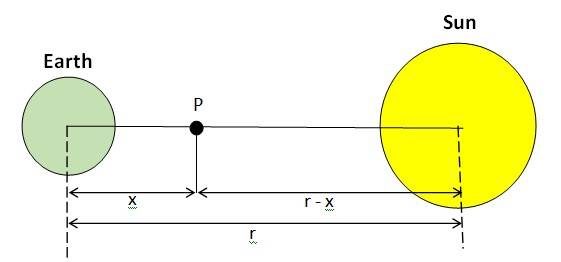Physics Gravitation
Get insights from 160 questions on Physics Gravitation, answered by students, alumni, and experts. You may also ask and answer any question you like about Physics Gravitation
Follow Ask QuestionQuestions
Discussions
Active Users
Followers
New answer posted
6 months agoContributor-Level 10
Mass of our galaxy Milky Way, M = 2.5 solar mass
Solar mass = Mass of the Sun = 2.0 kg
Mass of our galaxy = 2.5 2.0 = 5 kg
Diameter of the Milky Way, d = 105 ly
Radius of the Milky Way = 5 ly
1 ly = 9.46 m
r = 5 9.46 m = 4.73 m
As a star revolves around the galactic centre of the Milky Way, its time period is given by the relation: = ( = ( = 1.12 = 3.55 x years
New answer posted
6 months agoContributor-Level 10
The rotation period of the satellite Io, = 1.769 days = 1.769 x 24 x 60 x 60s
Radius of the Orbit is given by the relation, = 4.22 m
Mass is given by the relation: = ……(i)
Where = mass of Jupiter and G = Universal gravitational constant
Orbital period of the Earth, = 365.25 days = 365.25 x 24 x 60 x 60 s
Orbital radius of the Earth, = 1 AU = 1.496 x m
Mass of Sun is given as : = …(ii)
= = = ( = 1045.04
Hence it can be inferred that the mass of Jupiter is about one – thousandth that
New answer posted
6 months agoContributor-Level 10
Time taken by the Earth to complete one revolution around the Sun, = 1 year
Orbital radius of the Earth in its orbit, = 1 AU
Time taken by the planet to complete one revolution around the Sun, = = year
Orbital radius of the planet =
From Kepler's 3rd law of planetary motion, we can write:
( = (
= ( = ( = 0.63
Hence, the orbital radius of the planet will be 0.63 times smaller than that of the Earth
New answer posted
6 months agoContributor-Level 10
(a) Decreases - Acceleration due to gravity at depth h is given by = (1 – )g, where g = acceleration due to gravity on the surface of the Earth. From this equation, it is clear that acceleration due to gravity decreases with increase in height
(b) Decreases – Acceleration due to gravity at depth d is given by = (1- )g. So the acceleration due to gravity decreases with increase in depth.
(c) Mass of the body – Acceleration due to gravity of body mass m is given by the relation g = , where G = Universal gravitation constant, M = mass of the Earth and R = radius of the Ear
New answer posted
6 months agoContributor-Level 10
8.12
Mass of the Sun, = kg, Mass of the Earth, = kg
Orbital radius, r = m
Let the mass of the rocket be, m

Let x be the distance from the centre of the Earth where the gravitational force acting on satellite P becomes zero.
From Newton's law of gravitation, we can equate gravitational forces acting on the satellite P under the influence of the Sun and the Earth as:
= or(
= ( = ,
= 577.35 , r = 578.35x ,
x = = 2.59 m
New answer posted
6 months agoContributor-Level 10
Ans.8.1
(a) No. Unlike electrical forces, gravitational force is independent of the status of the objects.
(b) Yes, the size of the space station is large enough and the astronaut will detect the change in Earth's gravity.
(c) Tidal effect depends inversely upon the cube of the distance while gravitational force depends inversely on the square of the distance. Since the distance between the Moon and the Earth is smaller than the distance between the Sun and the Earth, the tidal effect of the Moon's pull is greater than the tidal effect of the Sun's pull.
New answer posted
7 months agoContributor-Level 10
When there is no normal force acting on a body, weightlessness is experienced, and the body free fall under gravity. The concept of gravity is still acting on the body, however, there is no weight sensation of any reaction force from any surface or ground. The weightlessness felt by the astronauts in an orbiting spacecraft is not because gravity is not present but because while they are moving forward, both, they and the spacecraft are in continuous free fall towards the Earth. The role of the normal force in defining weight can be understood from this phenomenon also how it is different from the actual gravitational force.
New answer posted
7 months agoContributor-Level 10
When there is no normal force acting on a body, weightlessness is experienced, and the body free fall under gravity. The concept of gravity is still acting on the body, however, there is no weight sensation of any reaction force from any surface or ground. The weightlessness felt by the astronauts in an orbiting spacecraft is not because gravity is not present but because while they are moving forward, both, they and the spacecraft are in continuous free fall towards the Earth. The role of the normal force in defining weight can be understood from this phenomenon also how it is different from the actual gravitational force.
Taking an Exam? Selecting a College?
Get authentic answers from experts, students and alumni that you won't find anywhere else
Sign Up on ShikshaOn Shiksha, get access to
- 65k Colleges
- 1.2k Exams
- 679k Reviews
- 1800k Answers
